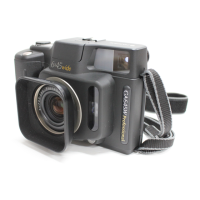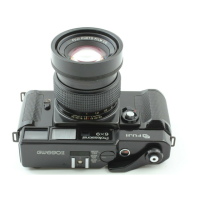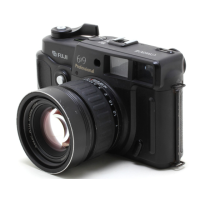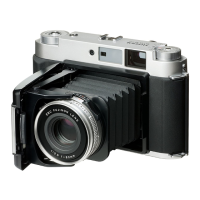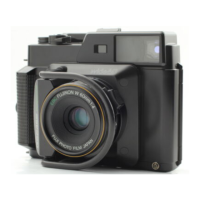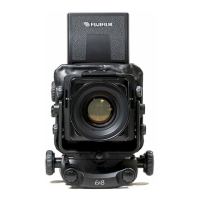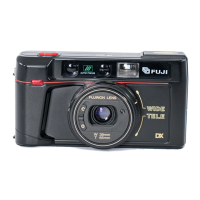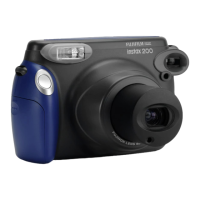Do you have a question about the FujiFilm GA645 and is the answer not in the manual?
Explains the different modes (OFF, P, A, M, ISO) of the selecting dial.
Details the functions of the up/down dial for various settings like aperture, film speed, and distance.
Provides instructions and warnings for cleaning the camera exterior and interior.
Details the correct procedure for cleaning the camera lens to avoid scratches.
Explains how the LCD display behaves at different temperatures.
Provides information and warnings regarding battery performance and usage.
Offers advice on storing the camera safely to protect it from environmental factors.
Advises on the proper method for loading and unloading film in subdued light.
Specifies the camera type as a fully automatic 6x4.5cm format autofocus camera.
Details the picture size captured by the camera as 6x4.5cm format.
States the types of film supported (120 and 220 roll film) and their respective exposures.
Describes the Super EBC Fujinon lens specifications, including focal length and components.
Explains the hybrid autofocus system and its focusing range.
Guides the user through the process of opening the compartment, inserting, and checking batteries.
Explains how to select and change the data format for printing on film.
Details how the set data format is printed outside the picture frames on the film.
Provides step-by-step instructions for setting the camera's date.
Guides the user through the process of setting the current time on the camera.
Instructions for attaching the neck strap to the camera securely.
Advises on using the soft case for protection and storage of the camera.
Explains the importance of using the lens cap to protect the lens from dust and debris.
Details how to attach filters and lens hoods, noting compatibility.
Describes attaching the viewfinder eyepiece and the availability of optional adjustment lenses.
Instructions on how to open the camera back safely.
Explains how to set the pressure plate correctly for different film types.
Details the number of exposures for 120 and 220 film and the role of the pressure plate.
Guides on pressing spool shaft buttons to prepare for film loading.
Instructions for replacing the empty spool in the take-up chamber.
Explains the correct method for inserting the film roll into the film chamber.
Details how to pull out the leader paper and insert it into the take-up spool.
Guides on winding the leader paper around the take-up spool for correct film tension.
Explains how to close the camera back to position the film for the first shot.
Explains how to take pictures easily using automatic modes like programmed auto exposure.
Guides on setting the film speed (ISO) using the selecting dial and up/down dial.
Instructions on how to pop up the flash head and prepare it for use.
Details the various markings and information displayed within the camera's viewfinder.
Provides guidance on how to hold the camera correctly for different shooting orientations.
Explains how to aim the camera and compose the shot using the AF mark.
Describes how to interpret the over/underexposure signs in the finder for correct exposure.
Guides on checking the shooting distance displayed in the finder and troubleshooting focus issues.
Instructions on pressing the shutter release to take a picture and the associated sounds.
Explains the indication when the last frame of film is reached and how the film is wound.
Explains how to set and use the aperture-priority auto exposure mode.
Guides on how to use manual exposure mode for intentional over/underexposure or specific lighting conditions.
Details how to ready and use the camera's built-in flash.
Explains flash operation for programmed auto exposure, including low light firing.
Describes flash operation for aperture-priority auto exposure, noting slow shutter speeds in dark conditions.
Details flash operation for manual exposure, where flash adjusts to aperture.
Provides a table showing the control range of the flash based on film speed and distance.
Instructions for attaching a compatible external flash to the camera's hot-shoe.
Illustrates the flash coverage area and potential light fall-off with different flashes.
Guides on setting exposure compensation values using the +/- button and dial.
Explains how the camera indicates that exposure compensation has been set.
Explains the concept and purpose of focus lock when the subject is off the AF spot.
Outlines the two methods for activating focus lock: using the shutter release or the manual focusing button.
Details the steps for using the shutter release method to lock focus.
Details the steps for using the manual focusing button to lock focus.
Explains how to switch the camera to manual focusing mode via the Autofocus Button.
Guides on setting the shooting distance manually using the dial.
Provides examples of when manual focusing is particularly useful, like for pan focus.
Explains how to activate the self-timer mode using the self-timer button.
Details how to start the self-timer and what to expect from the lamp and shutter.
Explains how to switch the distance display between meters and feet.
Guides on how to disable the camera's audible beeps for shutter and film end.
Describes the function of the total shots indicator for maintenance purposes.
Explains the active and passive methods used by the camera's autofocus system for accurate focusing.
Lists various subjects or conditions that may hinder the camera's autofocus performance.
Provides a table detailing the depth of field for various aperture and distance settings.
Explains the different modes (OFF, P, A, M, ISO) of the selecting dial.
Details the functions of the up/down dial for various settings like aperture, film speed, and distance.
Provides instructions and warnings for cleaning the camera exterior and interior.
Details the correct procedure for cleaning the camera lens to avoid scratches.
Explains how the LCD display behaves at different temperatures.
Provides information and warnings regarding battery performance and usage.
Offers advice on storing the camera safely to protect it from environmental factors.
Advises on the proper method for loading and unloading film in subdued light.
Specifies the camera type as a fully automatic 6x4.5cm format autofocus camera.
Details the picture size captured by the camera as 6x4.5cm format.
States the types of film supported (120 and 220 roll film) and their respective exposures.
Describes the Super EBC Fujinon lens specifications, including focal length and components.
Explains the hybrid autofocus system and its focusing range.
Guides the user through the process of opening the compartment, inserting, and checking batteries.
Explains how to select and change the data format for printing on film.
Details how the set data format is printed outside the picture frames on the film.
Provides step-by-step instructions for setting the camera's date.
Guides the user through the process of setting the current time on the camera.
Instructions for attaching the neck strap to the camera securely.
Advises on using the soft case for protection and storage of the camera.
Explains the importance of using the lens cap to protect the lens from dust and debris.
Details how to attach filters and lens hoods, noting compatibility.
Describes attaching the viewfinder eyepiece and the availability of optional adjustment lenses.
Instructions on how to open the camera back safely.
Explains how to set the pressure plate correctly for different film types.
Details the number of exposures for 120 and 220 film and the role of the pressure plate.
Guides on pressing spool shaft buttons to prepare for film loading.
Instructions for replacing the empty spool in the take-up chamber.
Explains the correct method for inserting the film roll into the film chamber.
Details how to pull out the leader paper and insert it into the take-up spool.
Guides on winding the leader paper around the take-up spool for correct film tension.
Explains how to close the camera back to position the film for the first shot.
Explains how to take pictures easily using automatic modes like programmed auto exposure.
Guides on setting the film speed (ISO) using the selecting dial and up/down dial.
Instructions on how to pop up the flash head and prepare it for use.
Details the various markings and information displayed within the camera's viewfinder.
Provides guidance on how to hold the camera correctly for different shooting orientations.
Explains how to aim the camera and compose the shot using the AF mark.
Describes how to interpret the over/underexposure signs in the finder for correct exposure.
Guides on checking the shooting distance displayed in the finder and troubleshooting focus issues.
Instructions on pressing the shutter release to take a picture and the associated sounds.
Explains the indication when the last frame of film is reached and how the film is wound.
Explains how to set and use the aperture-priority auto exposure mode.
Guides on how to use manual exposure mode for intentional over/underexposure or specific lighting conditions.
Details how to ready and use the camera's built-in flash.
Explains flash operation for programmed auto exposure, including low light firing.
Describes flash operation for aperture-priority auto exposure, noting slow shutter speeds in dark conditions.
Details flash operation for manual exposure, where flash adjusts to aperture.
Provides a table showing the control range of the flash based on film speed and distance.
Instructions for attaching a compatible external flash to the camera's hot-shoe.
Illustrates the flash coverage area and potential light fall-off with different flashes.
Guides on setting exposure compensation values using the +/- button and dial.
Explains how the camera indicates that exposure compensation has been set.
Explains the concept and purpose of focus lock when the subject is off the AF spot.
Outlines the two methods for activating focus lock: using the shutter release or the manual focusing button.
Details the steps for using the shutter release method to lock focus.
Details the steps for using the manual focusing button to lock focus.
Explains how to switch the camera to manual focusing mode via the Autofocus Button.
Guides on setting the shooting distance manually using the dial.
Provides examples of when manual focusing is particularly useful, like for pan focus.
Explains how to activate the self-timer mode using the self-timer button.
Details how to start the self-timer and what to expect from the lamp and shutter.
Explains how to switch the distance display between meters and feet.
Guides on how to disable the camera's audible beeps for shutter and film end.
Describes the function of the total shots indicator for maintenance purposes.
Explains the active and passive methods used by the camera's autofocus system for accurate focusing.
Lists various subjects or conditions that may hinder the camera's autofocus performance.
Provides a table detailing the depth of field for various aperture and distance settings.
| Lens | Fujinon 60mm f/4 |
|---|---|
| Image Size | 6 x 4.5 cm |
| Shutter | Electronically controlled leaf shutter |
| Film Format | 120/220 |
| Shutter Speed | 2s - 1/700s |
| Aperture Range | f/4 |
| Focus | Autofocus |
| Exposure Modes | Program AE, Aperture Priority, Manual |
| Flash | Built-in |
| Metering | Center-weighted average |
| ISO Range | 25 - 3200 |
| Flash Sync | All speeds |
| Battery | CR123A |
